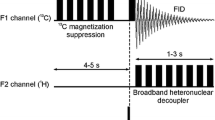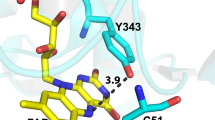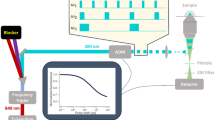Abstract
Four model compounds, for a tyrosine–histidine covalent bonding, 2-(5-imidazolyl)-4-methylphenol (C–C bonding in ortho-position at the phenyl group); 2′-(1-imidazolyl)-4-methylphenol (C–N bonding in ortho′-position at the phenyl group); 2-(5-imidazolyl)-4-H-phenol and 2-(5-imidazolyl)-4-H-phenol, at physiological pH have been studied by UV-Vis absorption, steady-state and time resolved fluorescence spectroscopy. Their absorption and emission properties are presented and discussed. The photophysical properties depend on the para-substituted phenyl group as well as on C–C/C–N bonding in the Phenol–Imidazole linkage. The N position, N1–N3/N1–N4, in the imidazole group was found to be relevant. The results are discussed with relevance to the redox processes of tyrosine and to better understand the role of a tyrosine–histidine covalent linkage as found in cytochrome c oxidase.








Similar content being viewed by others
References
Lakowicz JR (1999) Principles of fluorescence spectroscopy, 2nd edn. Kluwer Academic, Dordrecht, pp 448–514
Ross JBA, Laws WR, Roussland KW, Wyssbrod HR (1992) Tyrosine fluorescence and phosphorescence from proteins and polypeptides. In: Lakowicz JR (ed) Topics in fluorescence spectroscopy, vol. 3. Biochemical applications. Plenum, New York, pp 1–63
Seidel C, Orth A, Greulich K-O (1993) Electronic effects on the fluorescence of tyrosine in small peptides. Photochem Photobiol 58:178–184 doi:10.1111/j.1751-1097.1993.tb09546.x
Wiczk W, Rzeska A, Łukomska J, Stachowiak K, Karolczak J, Malicka J et al (2001) Mechanism of fluorescence quenching of tyrosine derivatives by amide group. Chem Phys Lett 341:99–106 doi:10.1016/S0009-2614(01)00470-5
Łukomska J, Rzeska A, Malicka J, Wiczk W (2001) Influence of substituent on amide nitrogen atom on fluorescence efficiency quenching of Tyr(Me) by amide groups. J Photochem Photobiol Chem 142:135–123 doi:10.1016/S1010-6030(01)00521-4
White A (1959) Effect of pH on fluorescence of tyrosine, tryptophan and related compounds. Biochem J 71:217–220
Szabelski M, Guzow K, Rzeska A, Malika J, Przyborowska M, Wiczk W (2002) Acidity of carboxyl group of tyrosine and its analogues and derivatives studied by steady-state fluorescence spectroscopy. J Photochem Photobiol Chem 152:73–78 doi:10.1016/S1010-6030(02)00187-9
Pal H, Palit DK, Mukherejee T, Mittal P (1990) Some aspects of steady state and time-resolved fluorescence of tyrosine and related compounds. J Photochem Photobiol Chem 52:391–409 doi:10.1016/1010-6030(90)85018-R
Wilis KJ, Szabo AG (1991) Fluorescence decay kinetics of tyrosinate and tyrosine hydrogen-bonded complexes. J Phys Chem 95:1585–1589 doi:10.1021/j100157a015
Laws WR, Ross JBA, Wyssbrod HR, Beechem JM, Brand L, Sutherland JC (1986) Time-resolved fluorescence and proton NMR studies of tyrosine and tyrosine analogs: correlation of NMR-determined rotamer populations and fluorescence kinetics. Biochemistry 25:599–607 doi:10.1021/bi00351a013
Rayner DM, Kraycarski DT, Szabo AG (1978) Excited state acid–base equilibrium of tyrosine. Can J Chem 56:1238–1245 doi:10.1139/v78-206
Fayet M, Wahl P (1971) Variation avec le pH du rendement quantique et du déclin de la fluorescence de la tyrosine. The variation in the quantum yield and fluorescence decay of tyrosine as a function of pH. Biochim Biophys Acta 221:102–112
Feitelson J (1964) On the mechanism of fluorescence quenching. Tyrosine and similar compounds. J Phys Chem 68:391–397 doi:10.1021/j100784a033
Guzow K, Szabelski M, Rzeska A, Karolczak J, Sulowska H, Wiczk W (2002) Photophysical properties of tyrosine at low pH range. Chem Phys Lett 362:519–526 doi:10.1016/S0009-2614(02)01135-1
Vos R, Engelborghs Y (1994) A Fluorescence study of tryptophan–histidine interactions in the peptide anantin and in solution. Photochem Photobiol 60:24–32
Pratt DA, Pesavento RP, van der Donk WA (2005) Model studies of the histidine–tyrosine cross link in cytochrome c oxidase reveal the flexible substituent effect of the imidazole moiety. Org Lett 7:2735–2738 doi:10.1021/ol050916g
Parker CA, Rees WT (1960) Corrections of fluorescence spectra and measurement quantum efficiency. Analyst (Lond.) 85:587–600 doi:10.1039/an9608500587
Chen RF (1967) Fluorescence quantum yields of tryptophan and tyrosine. Anal Lett 1:35–42
Farinha JPS, Martinho JMG, Pogliani L (1997) Non-linear least-squares and chemical kinetics. An improved method to analyse monomer–excimer decay data. J Math Chem 21:131–139 doi:10.1023/A:1019114217567
Moss D, Nabedryk E, Breton J, Mantele W (1990) Redox-linked conformational changes in proteins detected by a combination of infrared spectroscopy and protein electrochemistry. Evaluation of the technique with cytochrom c. Eur J Biochem 187:565–572 doi:10.1111/j.1432-1033.1990.tb15338.x
Hellwig P, Behr J, Ostermeier C, Richter OMH, Pfitzner U, Odenwald A et al (1998) Involvement of glutamic acid 278 in the redox reaction of the cytochrome c oxidase from Paracoccus denitrificans investigated by FTIR spectroscopy. Biochemistry 37:7390–7399 doi:10.1021/bi9725576
Marques AT, Silva JA, Silva MR, Beja AM, Justino LL, Sobral AJ (2008) X-ray diffraction and DFT studies of 2-methoxy-5-phenylaniline. J Chem Crystallogr 38:295–299 doi:10.1007/s10870-007-9306-6
Lakowicz JR, Weber G (1973) Quenching of fluorescence by oxygen. A probe for structural fluctuations in macromolecules. Biochemistry 12:4161–4170 doi:10.1021/bi00745a020
Lakowicz JR, Weber G (1973) Quenching of protein fluorescence by oxygen. Detection of structural fluctuations in proteins in the nanosecond time scale. Biochemistry 12:4171–4179 doi:10.1021/bi00745a021
Lakowicz JR, Maliwal BP (1983) Oxygen quenching and fluorescence depolarization of tyrosine residues in proteins. J Biol Chem 258:4794–4801
Shinitzky M, Goldman R (1967) Fluorometric detection of histidine–tryptophan complexes in peptides and proteins. Eur J Biochem 3:139–144 doi:10.1111/j.1432-1033.1967.tb19508.x
Ross JBA, Laws WR, Buku A, Sutherland JC, Wyssbrod HR (1986) Time-resolved fluorescence and 1H NMR studies of tyrosyl residues oxytocin and small peptides. Correlation and of NMR determined conformations of tyrosyl residues and fluorescence decay kinetics. Biochemistry 25:607–612 doi:10.1021/bi00351a014
Guzow K, Ganzynkowicz R, Rzeska A, Mrozek J, Szabelski M, Karolczak J et al (2004) Photophysical properties of tyrosine and its simple derivatives studies by time-resolved fluorescence spectroscopy, global analysis and theoretical calculations. J Phys Chem B 108:3879–3889 doi:10.1021/jp036721c
Hellwig P, Pfitzner U, Behr J, Rost B, Pesavento RP, v Donk W et al (2002) Vibrational modes of tyrosines in cytochrom c oxidase from Paracoccus denitrificants: FTIR and electrochemical studies on Tyr-D4-labeled and on Tyr280His and Tyr35Phe mutant enzymes. Biochemistry 41:9116–9125 doi:10.1021/bi012056r
Berthomieu C, Hienerwadel R (2005) Vibrational spectroscopy to study the properties of redox-active tyrosines in photosystem II and other proteins. Biochim Biophys Acta 1707:51–66 doi:10.1016/j.bbabio.2004.03.011
Acknowledgments
This work was supported by CNRS, ULP and ANR. M. Voicescu is grateful for financial support from the CNRS. The authors are indebted to Prof. van der Donk’s team, UIUC, Illinois, USA for Tyr–His model compounds synthesis.
Author information
Authors and Affiliations
Corresponding author
Rights and permissions
About this article
Cite this article
Voicescu, M., Heinrich, M. & Hellwig, P. Steady-State and Time Resolved Fluorescence Analysis on Tyrosine–Histidine Model Compounds. J Fluoresc 19, 257–266 (2009). https://doi.org/10.1007/s10895-008-0411-5
Received:
Accepted:
Published:
Issue Date:
DOI: https://doi.org/10.1007/s10895-008-0411-5




